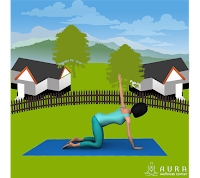Recently,
I was reading an article that is posted on the website of a well-known
spiritual teacher about the state of harmony, or "niscintata" in
Sanskrit. The Sanskrit concept of niscintata encompasses a balanced and equal
state of harmony, both with oneself and with one's surroundings. This is a tall
order, to be sure! In our fast-paced culture today, living in a balanced state
of harmony with oneself and one surroundings is usually not on the top of the
priority list.
Generally
speaking, most of us prioritize our time in such a way so that we are able to
meet our personal and professional goals in an efficient manner. Although
it is admirable to be able to pick your children up from school on time, pay a
mortgage payment by the due date each month or complete a task that your boss
has given you in a timely and efficient manner, if you do so in such a way that
your well being is compromised, an enormous variety of health problems may
develop over time.
The
traditional emphasis on living in harmony with oneself and one's environment
has the ability to reestablish a sense of being grounded and at peace in both
your body and mind. If you are teaching Yoga classes on a regular basis,
you will probably have noticed that many of your students come into class in a
rushed and harried fashion. This is usually due to the fact that many of your
students have a lot to juggle on a daily basis.
As a
certified Yoga teacher, you are in a particularly advantageous position to help
nurture a state of harmony in the lives of your students, both on and off the
mat. As you are probably aware, moving systematically through a balanced
sequence of Yoga postures on a regular basis helps to release tension,
strengthen the body and calm the mind. When you add the practice of the
traditional breathing practices of Yoga into the context of your classes, the
energizing, balancing and centering effects of the practice increases
exponentially.
In
addition, if you structure your Yoga classes in order to allow 5 - 10 minutes
at the conclusion of the physical practice of the postures for your students to
rest in the calm center of their being through the practice of meditation, you
will be substantially nurturing a state of inner harmony. Practicing pranayama
exercises prior to meditation will help your students to be able to meditate
more easily. Pranayama, or Yogic breathing exercises, can be practiced
either at the beginning of a class or at the end of class, just prior to
meditation and Shavasana.
Ujjayi
Pranayama, or Ocean Sounding Breath, is often practiced in conjunction with the
flow of the physical postures, particularly in vinyasa-style Yoga
classes. If your students correctly practice Ujjayi Pranayama, the right
and left hemispheres of the brain will become more balanced, and they will
experience a calm, energized sense of well being at the end of your
class. By linking together the practice of pranayama with meditation, your
Yoga students will be much more able rest in a state of awareness that is free
from mental agitation and worry.
For
instance, practicing Alternate Nostril Breathing, or Nadi Shodhana Pranayama,
will profoundly help to balance the left and right hemispheres of the brain, as
the body and mind are soothingly calmed and grounded in the present
moment. By leading your students through the practice of Alternate Nostril
Breathing for 3-5 minutes prior to engaging in meditation, the fluctuating
thought waves of their minds would be quelled. If all goes well, they will
experience an absence of mental agitation, at least for a few moments at a
time, which can ultimately pave the way for the experience of profound inner
peace.
Virginia Iversen, M.Ed, has been practicing and studying the art
of Yoga for over twenty years. She lives in Woodstock, New York, where she
works as a writer and an academic support specialist. She is currently
accepting Yoga and health-related writing orders and may be contacted at: enchantress108@gmail.com.
©
Copyright 2016 – Virginia Iversen / Aura Wellness Center – Publications
Division
See our
testimonials to find out what our graduates have to say about our selection of
online teacher certification courses.
Please feel
free to share our posts with your friends, colleagues, and favorite social
media networks.








